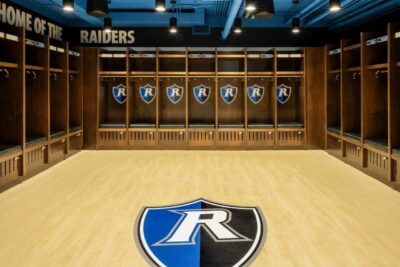
Dawn Proulx, Project Executive / Regional Operations Manager, New Hampshire
Dawn Proulx, Project Executive and NH Regional Operations Manager at Timberline, shares three key insights on how academic institutions can attract and maintain top student talent while keeping their budget in check.
Having partnered with dozens of academic institutions on their construction needs, we at Timberline understand that master planning is a critical tool for academic planners in aligning short and long-term institutional goals that will drive enrollment. The challenge lies in balancing academic offerings with student needs while ensuring your institution achieves sustainable and financially sound success. We’ve found that by honing in on top programming needs, assessing new construction vs. renovations and prioritizing preconstruction, academic institutions can make the most of their master plans.
1. Zeroing in on Your School’s Priorities
No two schools are alike. We understand each academic institution has its unique mission, values and set of priorities for the coming years which need to be weighed against available resources to attract and maintain their student body. Unfortunately, not every project can be undertaken at once, so schools are presented with the task of prioritizing the initiatives that will best advance their individual institution’s goals. Despite the differences from school to school, we’ve found certain academic trends are universally gaining momentum in engaging the best student talent:
- Flexible Tech-Enabled Spaces: With a growing number of university personnel and students adopting remote learning, adaptable workspaces are in high demand.
- Hoteling Offices: Shared, reservable workspaces for faculty and staff are a cost-effective option that can increase efficiency.
- Wellness & Well-Being: Schools are prioritizing a sense of community, focusing on mental health and accessibility to activities with greater use of their outdoor spaces.
- Sustainability Facilities: Rising concerns about environmental impacts have led to new energy code requirements driving academic institutions to incorporate sustainability in their master plans.
- Deferred Maintenance: Schools are addressing overdue maintenance issues to ensure the longevity and safety of facilities.
These trends are just a few examples of what we’re seeing in academic planning and recruitment efforts. By taking a holistic view of your institution and assessing the state of its facilities, you can hone in on the priorities that will make your strategy both impactful for students and attainable for your institution.
2. “Improve” Does Not Have to Mean “New”
While ground-up projects can be an appealing solution for academic needs, they are often costly and resource-intensive. We’ve found that in many instances, adapting existing facilities or undertaking smaller renovation projects can also yield significant results for your school.

Rivier University – Muldoon Fitness Center Locker Rooms
Take Timberline’s work with Rivier University as an example. Rather than opting for entirely new buildings, Rivier chose to enhance its campus by updating existing facilities. One project included the renovation of Brassard Hall, where our team transformed an outdated dormitory into a modern, apartment-style residence for 120 students with updated finishes to entice students. More recently, Timberline upgraded Rivier’s Muldoon Fitness Center, introducing state-of-the-art locker rooms that better serve the needs of current student-athletes and help attract top talent. As Jonathan Harper, Rivier University’s Director of Athletics puts it,
“I am blown away by the speed and quality construction that Timberline produced and the impact it will have. You have enriched the student-athlete experience on campus and will help us recruit the next generation of Raiders!”
While there are times when the long-term benefits of new construction outweigh the costs, our experience shows that thoughtful renovations to existing facilities can make a lasting impression on current and potential students. By making strategic upgrades, you can maximize the value of your current campus infrastructure and extend its utility and appeal.
3. Preconstruction as the Foundation for Success
Whether you’re considering a renovation or new construction, enlisting the right preconstruction team for your academic project is crucial to meeting your milestone dates and maximizing financial resources. Preconstruction planning can significantly impact a project, laying a strong foundation for subsequent phases of work while minimizing spend, schedule and risk.

Timberline’s preconstruction, design and construction team at Malden Catholic High School
At Timberline’s recent design-build project for Malden Catholic’s new academic building and athletic facility, our preconstruction team spent roughly five months from schematic design to Guaranteed Maximum Price (GMP) planning and preparing for construction. In this time our team meticulously balanced academic and athletic space requirements, providing our client with different programming options with real-time cost comparisons. This process not only optimized the building layout to enhance student programming but also ensured the project stayed within budget, yielding a strong return on Malden Catholic’s investment. Our diligent preconstruction efforts led to an alternate for HVAC equipment which resulted in $500,000 in cost savings for our client – a testament to the value of a thorough preconstruction process.
Focusing on these considerations along with individual school needs, academic institutions can effectively master their master plans. With a sound strategy in place, schools can attract top-tier talent and ensure student’s current and future needs are met while controlling costs. At Timberline, we offer cost-effective solutions like our in-house design-build services that can help streamline the process. Our team can also help navigate new requirements – like the recent energy code upgrades – to save your team unnecessary headaches and allow you to focus on your core academic objectives. Together, we can help you achieve your construction goals and set your school up for success.
Our design, preconstruction and construction experts are ready to help you maximize your budget and draw in academic talent. If you are interested in learning more, click here to connect with our team.
